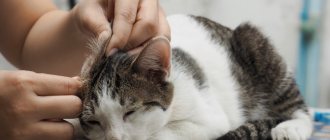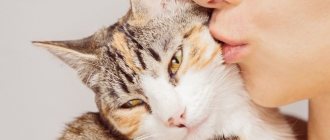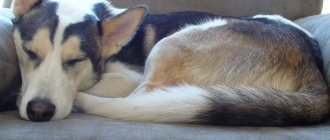Why does an umbilical hernia appear in a puppy?
A hernia is the prolapse of part of an organ through the umbilical opening. In many animals it appears as a congenital defect on the navel. In the mother's womb, the puppy receives nutrients through the umbilical cord; during the birth process, the umbilical ring contracts and closes within 24 hours after birth.
Puppies in which compression does not occur due to low tone of the abdominal wall or irregular shape of the abdominal ring subsequently suffer a hernia.
An umbilical hernia may not always be a congenital defect.
In adult dogs it can occur for a number of reasons.
Causes of umbilical cord in a puppy or adult dog:
- frequent constipation;
- severe bloating;
- prolonged vomiting;
- peritoneal trauma;
- difficult pregnancy;
- difficult birth.
Umbilical hernia in a dog
Causes of occurrence in dogs
If the puppies do not experience compression of the umbilical ring during birth, a hernia appears. Also the reason is the irregular shape of the umbilical ring.
In adults, pathology occurs in the following cases:
- regular constipation;
- severe bloating;
- prolonged vomiting;
- peritoneal damage;
- difficult pregnancy and childbirth.
The risk group includes pets with a weak constitution and exposed to regular physical activity. Older dogs are often diagnosed with pathology.
After abdominal surgery, intestinal problems also cause constipation. Normal overexertion during children's games leads to pathology. There is also a breed preference - it is common in German shepherds, dachshunds, cockers and poodles.
Types of hernia
Umbilical hernia is divided into several types:
- A false hernia looks like a soft ball. If you press it in, it will go in easily, and then the space will fill with fat. A false one with a diameter of more than 2 centimeters does not grow, does not change color and does not cause pain to the pet. The veterinarian may not insist on removing the false one.
- The true one can reach the size of a chicken egg. It is much more dangerous; parts of internal organs, such as an intestinal loop or uterus, fall out through the ring.
Removal of a hernia in a dog
is divided into two types according to the method of treatment:
- The repositionable one yields to finger pressure and goes inside easily.
- A pinched one is often fatal and causes a lot of pain to the pet. The contents of the pinched organ cannot be set without surgery; the ring has already narrowed and stopped the blood flow to the area of the prolapsed organ.
Diagnosis of hernias
Depending on the type of umbilical hernia, treatment will vary. During diagnosis by a veterinarian, the type of pathology is determined. The following types of disease are distinguished:
- True hernia - structurally consists of a hernial orifice formed by the umbilical ring and a protrusion formed by the hernial sac. The sac contains fragments of prolapsed organs, most often intestinal loops.
- False hernia - consists of the same components, but differs in that there is no content in the hernial sac. The internal organs are anatomically positioned correctly, and the sac is filled with fat. On palpation, softness and mobility are noted.
- Mobile hernia - with slight pressure, the contents of the hernial sac are freely pushed into the abdominal cavity.
- Irreducible hernia or hard one. This type of pathology is characterized by strangulation of the hernial orifice. Depending on the tone of the hernial orifice, the size of the hernial sac will depend. A small tumor easily grows to a large size with minor abdominal injuries, constipation and bloating. This type of hernia can come out and increase in size with coughing and severe vomiting. In adult animals, the hernia increases during pregnancy and during complicated childbirth.
During the examination by a veterinarian, a general clinical examination is carried out. The specialist prescribes a series of studies to determine the degree of neglect of the pathological process. Palpation and instrumental examination - ultrasound are prescribed. Ultrasound examination allows you to visualize all abnormalities in the abdominal cavity.
A mandatory diagnostic point is a laboratory general clinical blood test. The results allow us to determine the presence of inflammation. In acute conditions of the animal, urgent surgical intervention is prescribed.
Diagnostics
Only an experienced veterinarian can diagnose a dog with a lump and its type. If you notice a swelling on your puppy’s belly, you should immediately contact the clinic.
Inguinal hernia
The moment when the lump has already developed or led to pinching can be determined by how the animal behaves. The dog begins to whine, does not allow the lump to be touched, sits or lies in an unnatural position, diarrhea, and vomits. When pinched, tissue decomposition may begin, the dog experiences pain, the pulse quickens, and the body temperature rises. The only correct way out is to go to a veterinary clinic.
In case of strangulation, you should not give your pet antipyretic or anti-inflammatory drugs.
Hernia dimensions
If a small bump appears in the navel area of even an adult animal, you should urgently show your pet to a veterinarian. It is not a fact that the hernia will remain this size; it can grow to the size of a lemon or a chicken egg, depending on the size of the dog and the tone of the umbilical ring. This may not happen at all; the dog will live its entire life without knowing about the pathology. Or it can happen differently - the hernia will “grow” sharply even with a small load, pinching will occur and the pet will simply die within a few hours.
A lump in the navel area does not always indicate a hernia. It could be a harmless wen or a dangerous cancerous tumor. In any case, the pet should be shown to a doctor, even if it does not show signs of an uncomfortable condition.
Treatment regimen
The duration and treatment algorithm should be judged by the type of hernia and the age of the dog.
If you have a lump on your stomach, you must consult a doctor for examination.
The doctor determines the degree of development and type of disease in the animal by examination or ultrasound.
Treatment of reducible small sizes can allow non-intervention of the surgeon only in very small puppies. If the lump is insignificant and is pressed in with a finger, the doctor will prescribe a special bandage for the pet, which will compress the abdomen and prevent it from falling out. Such treatment will only help if the doctor is confident that the ring will tighten on its own.
In the case of a strangulated hernia, the pet will not survive without surgery.
The operation does not last long and is not complicated, however, it is done under general anesthesia.
Symptoms and types of illness
The most important symptom is a characteristic protrusion of the organ in the form of a ball or swelling, most often on the stomach (but can also be on the side, neck, back and other places). Depending on the manifestation and quality of the neoplasm, hernia is divided into several types.
Congenital hernia
Heredity plays a major role in the occurrence of pathology: the inguinal canal is too wide, poor tissue regeneration (due to which the umbilical canal does not heal). Often, rupture of abdominal tissue occurs due to improper obstetric care, which results in unhealthy babies being born with various muscle and bone problems.
Acquired
Other forms of hernia appear during the dog's life for various reasons related to stress on the abdominal muscles due to illness or surgery. The risk group includes animals with chronic high blood pressure, heart defects, problems with blood vessels and blood flow . More often than others, female miniature breeds suffer from acquired hernia due to childbirth or a difficult pregnancy.
True
The most dangerous form of manifestation: the muscle ring diverges by more than 2 cm, and part of the organ falls out into the formed form. The hernial ball can reach the size of an orange. Over time, the cavity stretches, enlarges, and compresses the tissue of the uterus or intestines, which contributes to tissue death.
If such a formation is detected, the pet must be taken to a veterinarian for examination. Correct palpation will indicate the possibility or impossibility of reduction.
False
A form in which the separated muscle tissue is filled with fat rather than an organ. The ball is small in appearance (up to 2 cm in diameter), soft to the touch, and can roll under the skin or be smoothed out. Surgery on the animal is not necessary.
False hernia in the photo
Reducible
Only a veterinarian can classify the formation according to the degree of reducibility . If the organ can be returned to its place, the hernia is called reducible. Upon palpation, the ball is elastic, soft, easily enters the muscle ring and remains there while the animal is motionless. In this case, an operation is performed to eliminate the hernial orifice.
Irreversible or hard
Such a hernia, rather, is a consequence of a truly reduced hernia, left without treatment. Appears when an organ is pinched in a muscular opening, tissue inflammation and the appearance of pus. Because of this, the cavity increases in size and cannot pass into the hernial orifice (it is hard, can bring pain and discomfort to the pet, and threatens health and life). Other symptoms also appear:
- Lethargy, lack of interest in life;
- Poor appetite;
- Temperature increase;
- When you tap on the cavity, a dull sound appears (like when playing a drum).
Caring for a sick animal
After the operation, the veterinarian prescribes anti-inflammatory antibiotics and mild painkillers in the form of injections. Rehabilitation after removal is quick.
You can speed up the healing of the suture with special ointments that disinfect, relieve swelling and inflammation.
In some cases, immunostimulants are prescribed to quickly restore health.
There can be no relapse of the disease after surgery. However, for preventative purposes, it is better to visit a veterinarian regularly for examination.
A number of vitamins and medications that support intestinal microflora must be included in the dog’s diet during treatment and rehabilitation.
Results
Umbilical hernia in puppies is a common occurrence, but despite this, not everyone has a critical condition.
The main thing is that if an umbilical hernia is detected in a puppy, it is necessary to immediately show it to a veterinarian to determine its condition.
Small umbilical hernias that do not grow progressively and do not create discomfort for the dog can be left in their original state and removed only if aesthetically necessary.
Perhaps, after completing a course of treatment, it will be possible to do without surgery.
Why is it dangerous for dogs?
A strangulated hernia is fatal, and it is impossible to repair it at home. When pinched, pressure in the abdomen increases, blood flow is disrupted, and tissues of internal organs die and rot. The rotting process provokes the entry of pathogenic bacteria into the blood and blood poisoning.
Hernia repair in a dog
Why are hernias on the navel dangerous?
Veterinarians recommend that the hernia be repaired without fail, and the sooner this happens, the less risk there is to the life and health of the animal. Even if a puppy has a formation, you should not expect it to resolve on its own. The reason for this is obvious - the umbilical ring can close at any time, and the contents of the skin sac will be pinched. Why is this dangerous?
- When the intestines are pinched, vomiting begins first and the dog suffers from constipation.
- If the pinching has absorbed part of the bladder, stagnation of urine will begin, which will lead to kidney failure.
- When pinched, a dog experiences severe pain.
- Blood circulation is impaired.
- Blood does not flow into the pinched part, a lack of oxygen begins, and the tissues pinched by the ring begin to die.
- Dead tissue disintegrates, which causes intoxication of the body.
- If no measures are taken, the dog will fall into a short coma and then die.
If the necrotic process has begun, then the animal owner will have a matter of minutes to deliver the pet to the clinic, and there he will immediately go to surgery, where the umbilical hernia will be removed.
Dogs with a false hernia do not require surgery; it is not dangerous to health unless the dog himself begins to scratch it and injure it.
How to tell if your dog has an umbilical hernia
An umbilical hernia is easy to detect by visually examining the dog or scratching its belly. Outwardly, it resembles a spherical tumor, often soft to the touch. The non-strangulated version does not in any way prevent the pet from moving, playing and eating, but if the umbilical ring nevertheless narrows, this can be determined by the following additional symptoms:
- pain factor, causing the dog to growl, whine, arch his back and limit his movements;
- decreased appetite or complete refusal to eat;
- problems with defecation, which are also often associated with pain in the abdominal area, back and neck;
- increased body temperature;
- increased breathing and increased heart rate up to 150 beats per minute for adults and over 200 for puppies;
- lack of coordination due to the dog's slow and careful movements (associated with painful hernia).
Due to the long coats of some breeds, it can be difficult to spot a small bump. But if it is not there, this does not mean that the problem was avoided. Carefully feel the navel area: it is likely that with light pressure it will be easier to determine it under your fingers than by eye.
How to determine and methods of treatment
In addition to the external manifestation of hernial protrusion, the pathology may be accompanied by symptoms characteristic of a violation of certain functions of the internal organs that are involved in this process. That is, if the intestines are strangulated, the clinical picture will be supplemented by indigestion, abdominal pain, vomiting, and diarrhea. If the heart or lungs are damaged, then these are signs of cardiac and pulmonary failure, etc.
Inguinal
Symptoms
The appearance under the skin in the groin of a soft, painless neoplasm that looks like a tied bag. There are usually no areas of baldness or ulceration in this area unless the hernia is hanging so low as to be irritated by friction. An inguinal hernia differs from an abscess in that the temperature of the “sac” coincides with body temperature. If in doubt, you can always do a diagnostic puncture of the contents of the protrusion. In some cases, infringement occurs. When the bladder is pinched in the inguinal ring when pressing on the hernial sac, the dog involuntarily urinates. There may be pain and difficulty urinating.
Treatment
Treatment of a hernia in the groin is only surgical, because Large intestinal loops and other organs may fall out. The slightest damage to them can lead to peritonitis (inflammation of the abdominal cavity), severe bleeding, and in pregnant women - to a miscarriage (if the uterus is pinched), so you cannot delay. If the uterus is involved in the process during pregnancy, it is possible to save the offspring in very rare cases.
Perineal
Symptoms
A diffuse, painless, soft protrusion is found in the perineal area. It can be distinguished from an inguinal hernia by touch, size and consistency - the perineal hernia is softer.
Treatment
In rare cases, the protrusion is reduced with fixation of the internal organs with a bandage; much more often, surgical intervention is required, because dysfunction of the injured organs increases very quickly.
Umbilical
Symptoms
In the navel area there is a clear protrusion of a soft consistency and most often spherical in shape. Usually painless (if without pinching). If it is reduced, then the boundaries of the umbilical ring can be clearly felt. If it is strangulated, there are signs of inflammation (swelling, pain, redness). In addition to local signs, strangulated pathology is accompanied by nausea, sometimes vomiting, refusal to eat and lethargy. An umbilical hernia is often observed in dogs after sterilization surgery.
Treatment
If the hernia is reducible, then local bandages with irritating ointments and/or alcohol injections around the hernial ring are sometimes prescribed in order to stimulate scarring and a decrease in diameter against the background of irritation. You can also apply simple adhesive plaster bandages in several layers, placing a thick cotton swab. If the hernia is irreducible, then surgical intervention is indicated. If an adult dog is undergoing surgery, it is necessary to wear a special surgical blanket to support the abdominal wall and prevent the sutures from coming apart.
Intervertebral
Symptoms
The symptoms of this hernia in a dog depend on where it occurs and how severely the spinal cord is compressed. Basically, this is a cautious gait, the inability to make sudden movements, the animal does not allow you to touch its back, cannot bend over to a bowl of food, and lack of coordination of the movement of one or both paws.
Treatment
If at least one such symptom appears, the dog is sent for an x-ray. It is imperative to determine the number of damaged intervertebral discs and the extent of their damage. Removal of a hernia in the spine is not often performed. If the injury is minor, the dog is provided with rest and anti-inflammatory therapy. In all other cases, then surgical intervention is the only option.
Diaphragmatic
Symptoms
If, against the background of a recent serious injury, the dog has heavy breathing, blue mucous membranes, the animal always only walks and never runs - you need to find time to take the pet to the veterinarian. If viscous, foamy saliva suddenly comes out of your mouth against the background of obvious shortness of breath and signs of suffocation, you need to look for a veterinarian immediately, because These are signs of pulmonary edema and there is a high risk of death.
Treatment
Treatment is only surgical along with rehabilitation therapy for the respiratory and cardiovascular systems. Not only the organ arrangement of the internal organs is restored, but also the hole in the diaphragm is eliminated.
Despite the fact that in some cases, literary sources suggest conservative treatment, bandages, bandages, irritating compresses and injections, etc., in practice, in most cases, a hernia always requires surgery. This minimizes the occurrence of relapses and severe complications. It is important not to delay surgery.
What to do and how to treat?
The method of treating a hernia depends on its severity. The diameter of an umbilical hernia is usually 1-2.5 cm. Small (less than 1 cm) hernias can close on their own between the ages of 3 and 6 months. Umbilical hernias that do not close over time may require surgery.
Important! Some small umbilical hernias do not require specific treatment and do not cause problems, and dogs live with them for the rest of their lives.
If the treatment of an umbilical hernia does not involve surgery, then the dog owner should examine his pet daily. A hernia that has not closed before the puppy is six months old requires contacting a veterinarian.
Important! Only a veterinarian can determine what the owner should do and how to treat an umbilical hernia in a puppy.
During the operation, the scar tissue formed around the hernia is removed, and the prolapsed organs are returned to their place. The operation is simple, the only risks are an incorrectly selected permissible dose of anesthetics, bleeding or the risk of infection. In many cases, surgery and removal of an umbilical hernia is associated with sterilization of the animal.
At the doctor
Important! Surgical correction of a hernia is the best method of eliminating the problem.
In the postoperative period, it is necessary to strictly follow the veterinarian’s recommendations until the dog’s complete recovery.
- The pet needs to be provided with comfortable conditions for rest.
- Your pet should eat well for the first few days after surgery . If your dog is nauseous, it is recommended not to feed it during the day, without limiting the consumption of clean water. The dog’s gastrointestinal functions return to normal after a few days.
- To ensure proper healing of the sutures, you should limit the dog's physical activity for ten days. During the walk, the dog must be on a leash and not be allowed to run, jump or play.
Any adverse reactions, unusual behavior of the dog, for example, drowsiness, lack of coordination, coughing or moaning, redness and swelling at the incision site are a good reason to visit the veterinarian. If the suture does not hold the internal organs and because of this any abdominal organ protrudes out at the incision site, you should consult a doctor immediately.
Inguinal hernia
Inguinal hernia, like umbilical hernia, occurs in dogs. An inguinal hernia in a dog can be congenital or acquired.
The cause of an inguinal hernia. Congenital inguinal hernias are a consequence of the defective anatomical structure of the inguinal-scrotal region at the stage of embryonic development. Acquired inguinal hernias are formed in dogs due to mechanical damage to the peritoneum, as well as reasons similar to the formation of an umbilical hernia.
Among veterinary specialists, it is also common to distinguish inguinal hernias depending on the condition of the contents of the hernia. According to this criterion, they are distinguished: reducible - when the contents of the hernia move freely, the tissues remain elastic, and the hernia itself is not accompanied by pain; irreducible - when the contents grow together with the hernial sac; strangulated - compression occurs in the hernia of the abdominal organs.
Symptoms. During visual inspection, owners and veterinarians note and palpate a raised swelling midway between the last nipple and the ischial tuberosity or at the level of the anterior edge of the pubic bones. Usually, the first symptom of this hernia in a dog is an increase in temperature to 42 degrees or higher, an increase in pulse and breathing, the dog has a frequent urge to “false” defecation, a reduction in the number of urinations, and as a result of severe pain the dog becomes agitated. The contents of an inguinal hernia include the omentum, intestinal loops, and sometimes the uterus. With a wide inguinal canal, with pressure or a dorsal position of the dog and an elevated pelvic part of the body, the swelling may disappear. If strangulated, the inguinal hernia becomes hard and painful. A sick dog often lies down and licks the skin surface of the hernia.
A veterinarian makes a diagnosis of an inguinal hernia during a clinical examination of a sick animal, by visually examining the dog and palpating the abdominal and groin area. During palpation, the clinic’s veterinary specialist will determine the hernial orifice of the sick dog, the type of hernia, and determine whether it is reducible or strangulated. To more accurately determine the contents of the inguinal hernia, the dog will undergo ultrasound diagnostics and, if necessary, radiography.
Treatment. Treatment for an inguinal hernia in a dog is only surgical. The sick dog is fixed in the dorsal position during the operation. Geniotomy is performed with combined anesthesia, as with an umbilical hernia. An incision in the skin and underlying tissues is made along the greater curvature of the swelling, 5-7 cm long, the hernial sac is prepared to the external inguinal ring and twisted along the longitudinal axis. A stitching ligature is applied to the hernial sac as high as possible, and below it is cut off. On the edges of the hernial sac, the veterinarian applies loop-shaped or combined sutures made of polymer or other synthetic absorbable threads, or ampuled catgut. The wound cavity is washed with antiseptic solutions, powdered with a complex powder and combined sutures made of silk or lavsan are applied.
Treatment method and prognosis
The main way to treat a hernia is surgery. In case of prolapse of organs and their infringement, this is generally the only way to save life. The displaced organs are returned to their place; if the tissue begins to die, they are excised, and the umbilical ring is sutured.
To improve healing and prevent the development of infection, the animal is prescribed drug therapy, including painkillers, anti-inflammatory drugs, and antibiotics.
With timely intervention, the prognosis is positive. There is a risk of re-formation of hernias, so animal care and preventive measures are of great importance.
Kinds
There are several types of hernia:
- A perineal hernia in dogs is a consequence of a weakening of the pelvic diaphragm, which prevents the penetration of abdominal contents into the subcutaneous tissue of the perineum. Weakening of the pelvic diaphragm leads to displacement of the pelvic and abdominal organs (rectum, prostate, bladder) towards the anus. The first signs of a perineal hernia in dogs are constipation and swelling around the anal area. The abdominal wall consists of dense tissue and three muscle layers that support the internal organs of the abdominal cavity. The groin area has a small opening called the inguinal canal. Blood vessels and the spermatic cord pass through it to the testicles (in males). Bitches have something like an inguinal canal, which has an abdominal opening. The gap in the inguinal canal is small enough for the internal organs to spill out of the abdominal cavity.
- An inguinal hernia in dogs is a condition in which the inguinal canal becomes stretched so that abdominal organs can fall through it. This can cause part of the intestine to become trapped outside the abdominal cavity, leading to progressive deterioration of blood flow and intestinal necrosis.
- The dog's spinal cord is enclosed in a canal formed by the vertebrae. Between the vertebrae are cushions called intervertebral discs, which act as shock absorbers and prevent the vertebrae from rubbing against each other. As a dog ages, the vertebrae begin to degenerate and weaken. As a result of this process, or perhaps due to previous trauma by the dog, the outer lining of the disc ruptures and the gel-like mass inside the disc leaks and forms a herniated disc .
- The most common hernia in domestic dogs is umbilical . An umbilical hernia in a dog on the abdomen is a bulge in the walls of the abdominal cavity, visceral (abdominal) fat or part of the abdominal organs, localized in the peri-umbilical area.
Umbilical hernia
Interesting fact! Many dog owners don't know where their dog's belly button is or whether it even has one. The navel in dogs and cats is a small round spot similar to a bald patch. In long-haired dogs it is impossible to see it with the naked eye. The navel is located in the middle part of the abdomen just below the rib cage.
Umbilical hernia in dogs occurs:
- Reducible - a fragment of an organ that has fallen out through the umbilical ring can be returned to its place by applying physical pressure.
- Strangulated - the prolapsed part of the organ is pinched by the umbilical ring, as a result of which the hernia increases in size. In this case, surgical intervention is required.
- False - in the navel area there is a small rounded formation. When you press on it, it dissolves. A false hernia fills with fat over time.
- The size of a true hernia varies from a small lesion to the size of an orange. This type of umbilical hernia is dangerous not only for the dog’s health, but also for its life.
Important! The appearance of any neoplasms on a dog’s body is a reason to contact a veterinarian. Any form of hernia requires diagnosis and clinical therapy.
Symptoms
An imaginary hernia has a cross-section of less than 20 mm and is soft to the touch. Signs of true prolapse depend on the degree of impingement. An unreducible hernia reaches the size of a small melon. The following signs of infringement are noted:
- it hurts the dog when palpated;
- the tumor swells and is colored differently from adjacent tissues;
- the animal stops feeding;
- the dog is depressed;
- body temperature is increased.
The greatest danger is the loss of a hernia during pregnancy and after a pathological birth.
True











